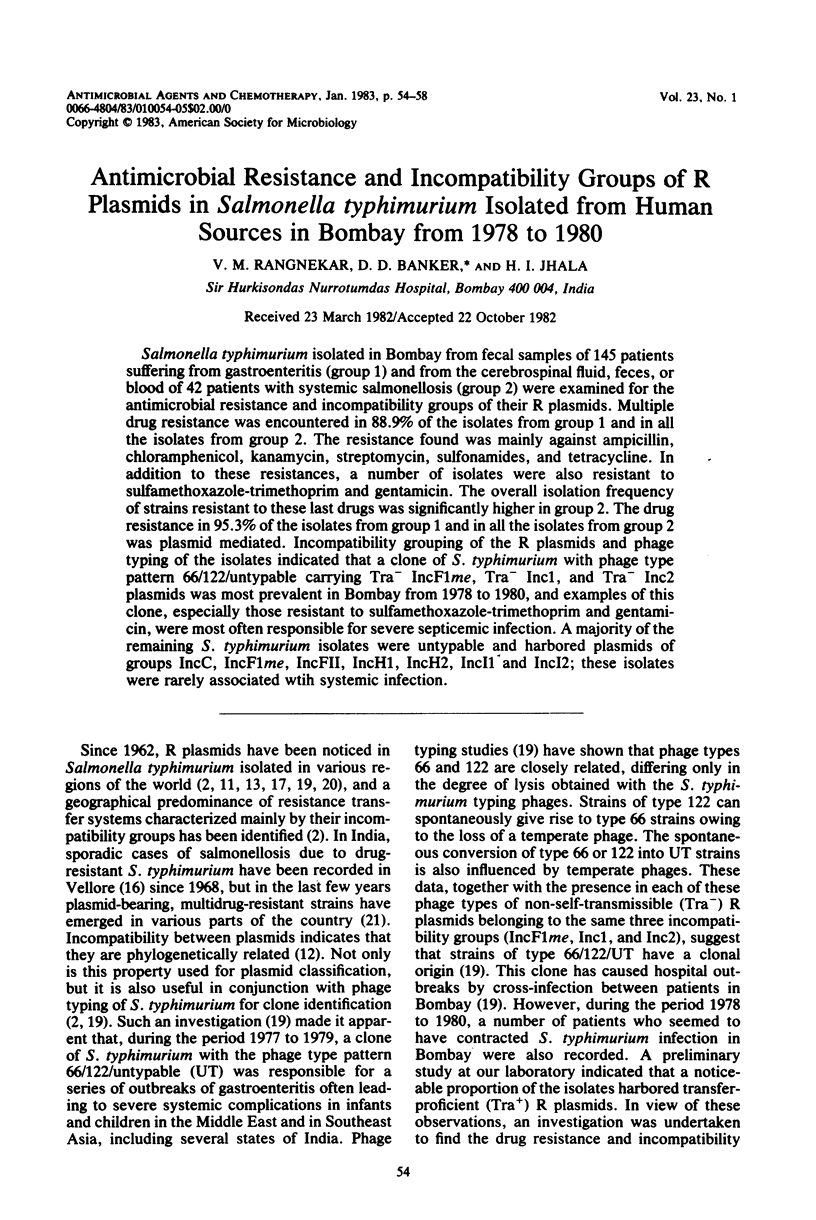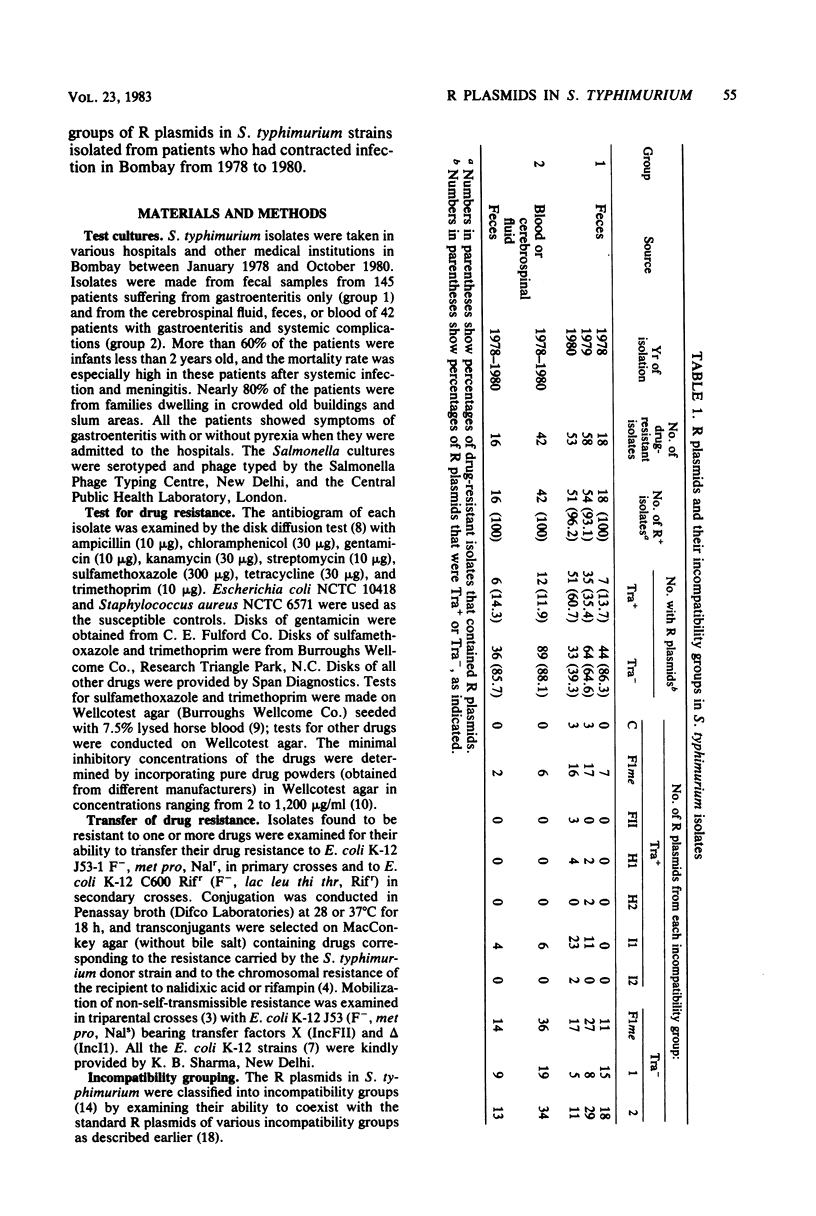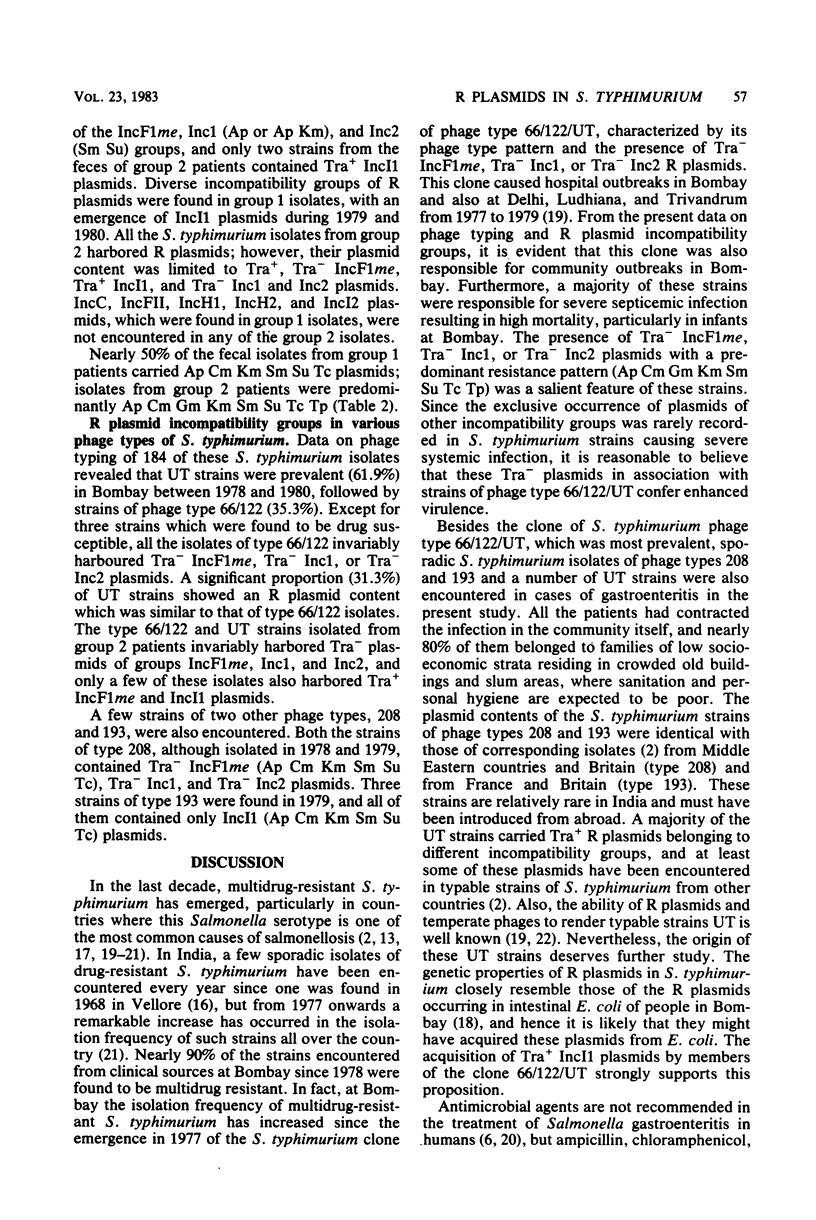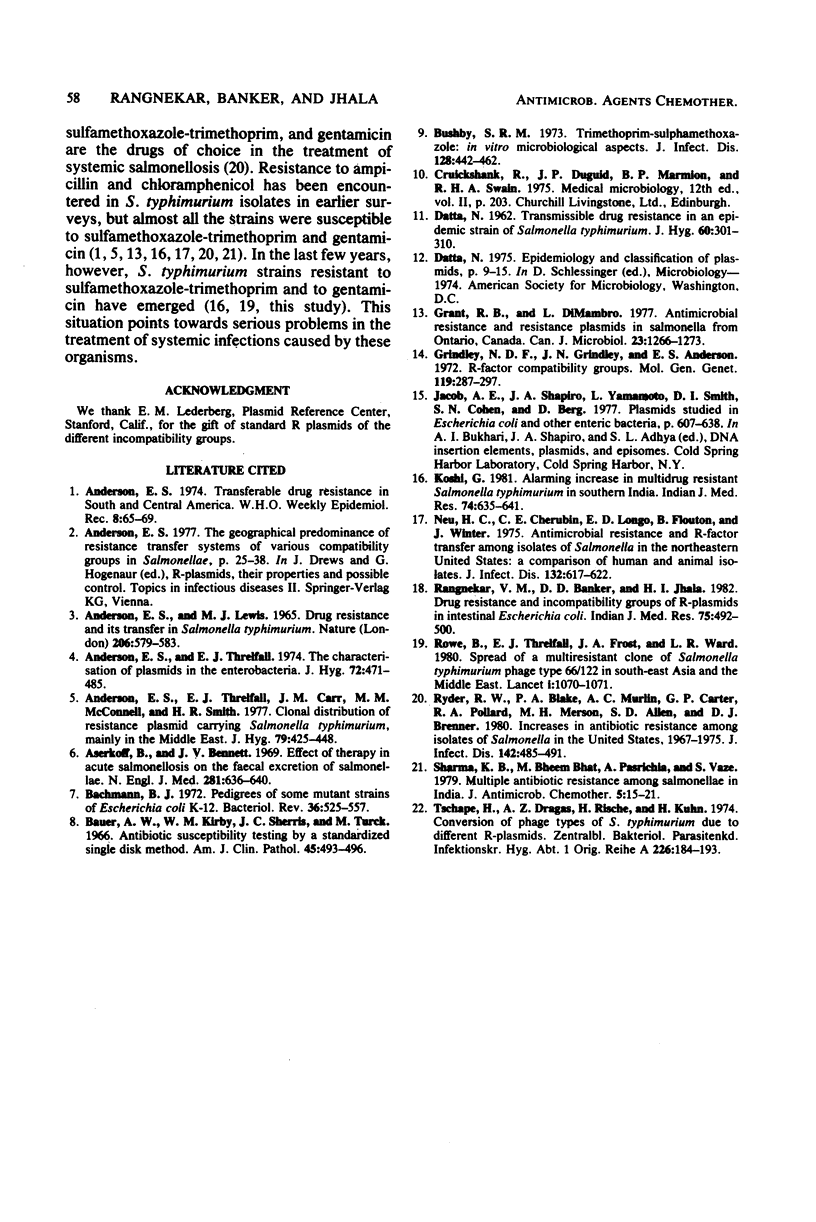Abstract
Salmonella typhimurium isolated in Bombay from fecal samples of 145 patients suffering from gastroenteritis (group 1) and from the cerebrospinal fluid, feces, or blood of 42 patients with systemic salmonellosis (group 2) were examined for the antimicrobial resistance and incompatibility groups of their R plasmids. Multiple drug resistance was encountered in 88.9% of the isolates from group 1 and in all the isolates from group 2. The resistance found was mainly against ampicillin, chloramphenicol, kanamycin, streptomycin, sulfonamides, and tetracycline. In addition to these resistances, a number of isolates were also resistant to sulfamethoxazole-trimethoprim and gentamicin. The overall isolation frequency of strains resistant to these last drugs was significantly higher in group 2. The drug resistance in 95.3% of the isolates from group 1 and in all the isolates from group 2 was plasmid mediated. Incompatibility grouping of the R plasmids and phage typing of the isolates indicated that a clone of S. typhimurium with phage type pattern 66/122/untypable carrying Tra- IncF1me, Tra- Inc1, and Tra- Inc2 plasmids was most prevalent in Bombay from 1978 to 1980, and examples of this clone, especially those resistant to sulfamethoxazole-trimethoprim and gentamicin, were most often responsible for severe septicemic infection. A majority of the remaining S. typhimurium isolates were untypable and harbored plasmids of groups IncC, IncF1me, IncFII, IncH1, IncH2, IncI1 and IncI2; these isolates were rarely associated with systemic infection.
Full text
PDF




Selected References
These references are in PubMed. This may not be the complete list of references from this article.
- Anderson E. S., Lewis M. J. Drug resistance and its transfer in Salmonella typhimurium. Nature. 1965 May 8;206(984):579–583. doi: 10.1038/206579a0. [DOI] [PubMed] [Google Scholar]
- Anderson E. S., Threlfall E. J., Carr J. M., McConnell M. M., Smith H. R. Clonal distribution of resistance plasmid-carrying Salmonella typhimurium, mainly in the Middle East. J Hyg (Lond) 1977 Dec;79(3):425–448. doi: 10.1017/s0022172400053286. [DOI] [PMC free article] [PubMed] [Google Scholar]
- Aserkoff B., Bennett J. V. Effect of antibiotic therapy in acute salmonellosis on the fecal excretion of salmonellae. N Engl J Med. 1969 Sep 18;281(12):636–640. doi: 10.1056/NEJM196909182811202. [DOI] [PubMed] [Google Scholar]
- Bachmann B. J. Pedigrees of some mutant strains of Escherichia coli K-12. Bacteriol Rev. 1972 Dec;36(4):525–557. doi: 10.1128/br.36.4.525-557.1972. [DOI] [PMC free article] [PubMed] [Google Scholar]
- Bauer A. W., Kirby W. M., Sherris J. C., Turck M. Antibiotic susceptibility testing by a standardized single disk method. Am J Clin Pathol. 1966 Apr;45(4):493–496. [PubMed] [Google Scholar]
- Bushby S. R. Trimethoprim-sulfamethoxazole: in vitro microbiological aspects. J Infect Dis. 1973 Nov;128(Suppl):442–p. doi: 10.1093/infdis/128.supplement_3.s442. [DOI] [PubMed] [Google Scholar]
- DATTA N. Transmissible drug resistance in an epidemic strain of Salmonella typhimurium. J Hyg (Lond) 1962 Sep;60:301–310. doi: 10.1017/s0022172400020416. [DOI] [PMC free article] [PubMed] [Google Scholar]
- Grant R. B., Di Mambro L. Antimicrobial resistance and resistance plasmids in Salmonella from Ontario, Canada. Can J Microbiol. 1977 Sep;23(9):1266–1273. doi: 10.1139/m77-190. [DOI] [PubMed] [Google Scholar]
- Grindley N. D., Grindley J. N., Anderson E. S. R factor compatibility groups. Mol Gen Genet. 1972;119(4):287–297. doi: 10.1007/BF00272087. [DOI] [PubMed] [Google Scholar]
- Koshi G. Alarming increase in multi-drug resistant Salmonella typhimurium in southern India. Indian J Med Res. 1981 Nov;74:635–641. [PubMed] [Google Scholar]
- Neu H. C., Cherubin C. E., Longo E. D., Flouton B., Winter J. Antimicrobial resistance and R-factor transfer among isolates of Salmonella in the northeastern United States: a comparison of human and animal isolates. J Infect Dis. 1975 Dec;132(6):617–622. doi: 10.1093/infdis/132.6.617. [DOI] [PubMed] [Google Scholar]
- Rangnekar V. M., Banker D. D., Jhala H. I. Drug resistance and incompatibility groups of R-plasmids in intestinal Escherichia coli. Indian J Med Res. 1982 Apr;75:492–500. [PubMed] [Google Scholar]
- Rowe B., Frost J. A., Threlfall E. J., Ward L. R. Spread of a multiresistant clone of Salmonella typhimurium phage type 66/122 in South-East Asia and the Middle East. Lancet. 1980 May 17;1(8177):1070–1071. doi: 10.1016/s0140-6736(80)91509-3. [DOI] [PubMed] [Google Scholar]
- Ryder R. W., Blake P. A., Murlin A. C., Carter G. P., Pollard R. A., Merson M. H., Allen S. D., Brenner D. J. Increase in antibiotic resistance among isolates of Salmonella in the United States, 1967-1975. J Infect Dis. 1980 Oct;142(4):485–491. doi: 10.1093/infdis/142.4.485. [DOI] [PubMed] [Google Scholar]
- Sharma K. B., Bhat M. B., Pasricha A., Vaze S. Multiple antibiotic resistance among salmonellae in India. J Antimicrob Chemother. 1979 Jan;5(1):15–21. doi: 10.1093/jac/5.1.15. [DOI] [PubMed] [Google Scholar]
- Tschäpe H., Dragas A. Z., Rische H., Kühn H. Conversion of phage types of S. typhi-murium due to different R-plasmids. Zentralbl Bakteriol Orig A. 1974 Feb;226(2):184–193. [PubMed] [Google Scholar]


